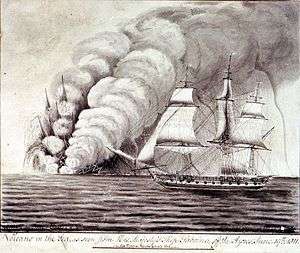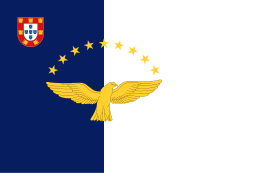Sabrina Island (Azores)

Sabrina Island was an islet formed during the months of June and July 1811 by a submarine volcanic eruption off Ponta da Ferraria, São Miguel Island, Azores, one of many that have been felt in the Sete Cidades Massif over time. The first person to land in the new island was Commander James Tillard, captain of the British warship HMS Sabrina, who hoisted the Union Jack on the island and claimed sovereignty for Great Britain. A diplomatic row over the issue ensued, which the island's sinking back into the sea rendered moot.
History
Between January and February 1811 a prolonged period of seismic activity affected the settlements to the extreme southeast, in particular, the parish of Ginetes. During these months, gases were emitted from the ocean around Ponta da Ferraria, but, by the end of the month of February they abruptly ceased. New tremors returned in May and June, destroying many homes. Finally on June 10, 1811, in an area about 3 nautical miles (5.6 km) from the original seismic zones, and about 2 kilometers off the coast, a submarine eruption occurred alongside Ponta da Ferraria, killing fish of many species. A circular cone formed that had a perimeter of 2 kilometers, and 90 meters in height (similar in respects to the Islet of Vila Franca do Campo) with an open ring to the northwest. From the central ring debris escaped into the sea.
On June 12, the eruption was visible by the British sloop Sabrina, which was patrolling the Azores. Commander James Tillard, thinking that the grey clouds in the area were from a naval battle, sailed to the area but found a situation that was quite different than he originally imagined. He later wrote a description of the eruption and his visit to the island for the Philosophical Transactions of the Royal Society.[1]
References
- Notes
- ↑ Tillard (1812), pp.152–8.
- Sources
- "A Ilha Sabrina e a Erupção Submarina em S. Miguel de 1811", Insulana, 3/4 (7), Ponta Delgada (Azores), Portugal, 1951, pp. 260–265
- Humboldt, Alexander von (1851), Cosmos: A Sketch of a Physical Description of the Universe, 1, London, England: Henry G. Bohn, p. 242
- Webster, John White (1822), Description of the Island of St. Michael, comprising an account of its Geological Structure; with Remarks on the Other Azores or Western Islands, Boston, Massachusetts: R.P. & C. Williams
- Tillard, James (1812), "A Narrative of the Eruption of a Volcano in the Sea off the Island of St. Michael", Philosophical Transactions of the Royal Society of London, 102, London, England, pp. 152–158, 422–423
